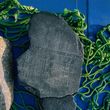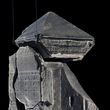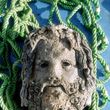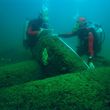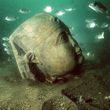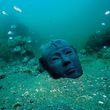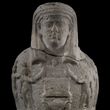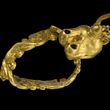Sunken Civilizations
Following traces of legend and history
The ancient city of Canopus is mentioned many times by classical authors and the fathers of the church. The oldest mention of Canopus can be found in a poem by Solon, from the first half of the 6th century BC. According to the poet Nicander (2nd century BC), Menelaus’ helmsman, Canopus, died here, bitten by a viper on the sands of Thonis. The city located close by was named after this unfortunate sailor: Canopus. During the last Pharaonic dynasties and the Ptolemaic period, Canopus was famous for its sanctuaries of Osiris and Serapis. Pilgrims from all over the world came to visit in search of miraculous healing.
Throughout the existence of the grand temple of Amun-Gereb in Thonis-Heracleion, the God Osiris was taken from here on his ritual barque to his sanctuary in Canopus. This yearly procession of the Mysteries of Osiris created a mystical tie between the two neighbouring cities. During Roman times Canopus was condemned in literature for its extravagant feasts, however, attracting many visitors. Emperor Hadrian, in order to keep alive the memories of the good times he enjoyed in Canopus, even had a replica of part of Canopus built at Villa Hadriana outside Rome. After the destruction of the temples by Christian iconoclasts, the construction of a powerful monastery followed. It became famous for holding the relics of Saint John and Saint Cyril. Those relics brought to the monastery the same powers for miraculous healings as the former pagan temple of Osiris-Serapis and consequently the site continued to be a place of pilgrimage.
The fate of Canopus was identical to that which befell Thonis-Heracleion: the sea repossessed these places with their rich histories.
The Discovery
Two kilometres to the east of the modern port of Aboukir, the IEASM have identified a zone that contains numerous archaeological remains, including some that clearly corresponded to those discovered by Prince Toussoun in 1933. This site consists of a row of ruins 150 metres long. Broken shafts of columns of red granite are combined with limestone construction blocks and other architectural elements. Artefacts, including jewels, crosses, coins and seals of the Byzantine Period, were found during the IEASM investigations here. To the north of these structures, under almost two metres of sand, are the well-preserved foundations of a wall that measures 103 metres long. It is suggested that this wall would have surrounded a temple, which from the scale of the wall would be the largest Egyptian shrine found thus far in the region.
Pieces of granite inscribed with hieroglyphs were found here. These proved to be further parts of the Naos of the Decades, a famous monolithic chapel, parts of which had already been found underwater at this location by Prince Toussoun in 1933. Among the other fragments of statuary found in this area was a remarkable marble head of the god Serapis, dating from the Ptolemaic Period.







